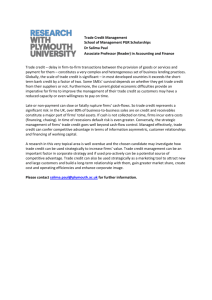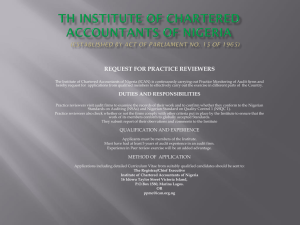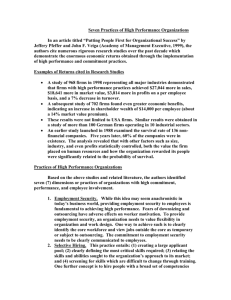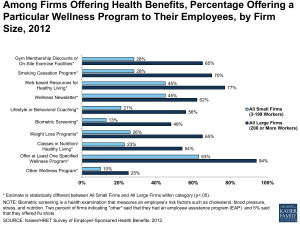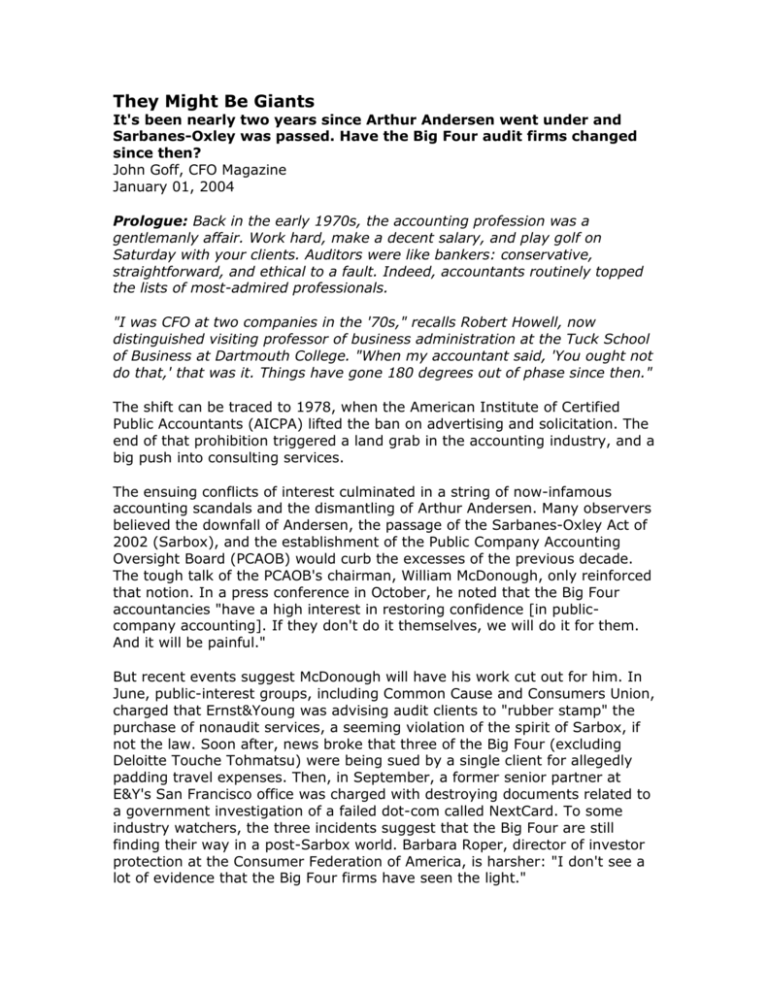
They Might Be Giants
It's been nearly two years since Arthur Andersen went under and
Sarbanes-Oxley was passed. Have the Big Four audit firms changed
since then?
John Goff, CFO Magazine
January 01, 2004
Prologue: Back in the early 1970s, the accounting profession was a
gentlemanly affair. Work hard, make a decent salary, and play golf on
Saturday with your clients. Auditors were like bankers: conservative,
straightforward, and ethical to a fault. Indeed, accountants routinely topped
the lists of most-admired professionals.
"I was CFO at two companies in the '70s," recalls Robert Howell, now
distinguished visiting professor of business administration at the Tuck School
of Business at Dartmouth College. "When my accountant said, 'You ought not
do that,' that was it. Things have gone 180 degrees out of phase since then."
The shift can be traced to 1978, when the American Institute of Certified
Public Accountants (AICPA) lifted the ban on advertising and solicitation. The
end of that prohibition triggered a land grab in the accounting industry, and a
big push into consulting services.
The ensuing conflicts of interest culminated in a string of now-infamous
accounting scandals and the dismantling of Arthur Andersen. Many observers
believed the downfall of Andersen, the passage of the Sarbanes-Oxley Act of
2002 (Sarbox), and the establishment of the Public Company Accounting
Oversight Board (PCAOB) would curb the excesses of the previous decade.
The tough talk of the PCAOB's chairman, William McDonough, only reinforced
that notion. In a press conference in October, he noted that the Big Four
accountancies "have a high interest in restoring confidence [in publiccompany accounting]. If they don't do it themselves, we will do it for them.
And it will be painful."
But recent events suggest McDonough will have his work cut out for him. In
June, public-interest groups, including Common Cause and Consumers Union,
charged that Ernst&Young was advising audit clients to "rubber stamp" the
purchase of nonaudit services, a seeming violation of the spirit of Sarbox, if
not the law. Soon after, news broke that three of the Big Four (excluding
Deloitte Touche Tohmatsu) were being sued by a single client for allegedly
padding travel expenses. Then, in September, a former senior partner at
E&Y's San Francisco office was charged with destroying documents related to
a government investigation of a failed dot-com called NextCard. To some
industry watchers, the three incidents suggest that the Big Four are still
finding their way in a post-Sarbox world. Barbara Roper, director of investor
protection at the Consumer Federation of America, is harsher: "I don't see a
lot of evidence that the Big Four firms have seen the light."
Rope-a-Dope
You can't really blame the Big Four for not owning up to any past mistakes.
Any admission that previous audits were not as rigorous as they might have
been could expose the firms to shareholder lawsuits. Publicly, the four firms
have expressed general concern over the tarnishing of the audit profession.
PricewaterhouseCoopers vice chairman John O'Connor concedes that he was
embarrassed by the accounting scandals of the past few years: "We asked
ourselves, 'Have we lost our nobility?'" Even before the scandals hit, the
accountancy had instituted PwC University, a five-day seminar to help
employees deal with the kinds of stresses auditors experience.
Nevertheless, O'Connor asserts that PwC's biggest mistake during the past
few years was that it simply lost sight of the value of its core audit service:
"We had underinvested in some of our services, including audit."
Sarbox was intended, in part, to refocus audit firms on auditing. To some
extent, it has, by prohibiting auditors from offering certain consulting
services altogether and allowing them to offer others only to nonaudit clients.
In addition, auditors are meeting more often with corporate audit
committees, which are now empowered to hire and fire the firms. That's a
definite power shift. "Audit committees are our clients now," notes Susan
Frieden, Americas vice chair of quality and risk management at E&Y.
CFOs say engagement partners have become more conservative in the wake
of Sarbox as well. At a recent conference at MIT's Sloan School of
Management, Howard Smith, CFO of insurer AIG, noted that the amount of
time spent getting feedback from the company's auditors has "grown
tremendously" for complicated accounting issues. At the same conference,
John Millerick, CFO of Analogic, said bluntly: "There are no quick answers
[from our auditors] anymore."
Others argue that Sarbox could have gone further. "Sarbox was just triage,"
asserts Cynthia Smith, a lecturer at Ohio State University and co-author of
Inside Arthur Andersen. "It addressed a number of obvious things." Under
Section 203 of the act, for example, firms are required to rotate lead audit
partners every five years. But critics say legislators should have required
companies to change firms every five years (a stipulation E&Y vice chairman
Beth Brooke labels "a horrible idea").
What's more, Andersen's downfall has actually proven to be a windfall for the
remaining top-tier firms, which picked up the disgraced firms' clients. E&Y,
for one, reported revenues of $13.1 billion for its fiscal year 2003, a 30
percent rise from the previous year. And PwC's aggregated net revenue for
its fiscal year 2003 was $14.7 billion, a jump of nearly $1 billion.
In fact, it appears the Big Four have managed to neatly ride out the storm of
investor and congressional criticism triggered by the Andersen scandal. "The
Big Four firms are very good at taking blows, doing the rope-a-dope," says
Stephen Giusto, CFO at Costa Mesa, California-based consulting firm
Resources Connection Inc. and a former partner at a marquee firm. "But
there's been very little change to how they do business."
Auditors disagree, pointing to the creation of the PCAOB as just one example
of an industry in flux. "It's a big change from self-regulation to regulation,"
asserts O'Connor.
Indeed, the end of the peer-to-peer review system has been hailed by both
audit firms and their critics. The PCAOB has also garnered praise for its
decision, taken early on, to limit the role of the AICPA in the making of auditindustry standards. But the reality is, the Big Four audit the financial
statements of the public companies that generate 99 percent of all revenues
in the public sector. That's not likely to change anytime soon. Officials of the
Big Four think there's plenty of competition in the sector. "It's not unusual to
have three or four major players in an industry [that's gone through
consolidation]," says O'Connor. "It's still very competitive for clients." Adds
E&Y's Brooke: "Four firms is a workable number."
Charles Mulford has a different view. Mulford, a professor of accounting at
the Georgia Institute of Technology, recounts the story of one large
corporation that recently decided to dump its auditor of record (a Big Four
firm). Of the remaining three top-tier firms, one already provided the
company with consulting services, knocking that firm out of contention. In
addition, Mulford says the chairman of the company didn't like a key partner
at one of the two remaining Big Four audit houses. "The company ended up
sending out an RFP to one firm," he says.
McDonough acknowledges the scarcity of audit choices for large corporations.
"The lack of competition is a problem...," he says. "But what can be done
about it?" Very little (see "Return of the Big Eight?" at the end of this article).
"Four firms is close to a big problem already," says Giusto. "Anything less
would be a complete disaster."
Given that prospect, it's doubtful the PCAOB would put any of the top-tier
firms out of commission. "If there's a shortcoming to oversight," says
Mulford, "it's that the PCAOB can't let another [big firm] fail. If firms get to a
situation where they know this, it could be a problem." Roper thinks it's
already a problem. "At this point," she says, "the PCAOB is boxed in."
Oh, Calcutta!
This is not to say the accounting oversight board won't flex its regulatory
muscle. Rather than going after firms, however, the board will likely punish
individual partners.
There are plenty of those. On average, the Big Four firms (which are set up
as limited liability partnerships) employ about 6,600 partners. The LLP
structure, which merits full partnership tax treatment, shields the firms'
partners from vicarious liability. Unlike a corporation, which is hierarchical,
an LLP is by nature decentralized. In some cases, the setup can create a Wild
West mentality, in which partners at headquarters-level have relatively little
control over conduct at local offices.
While the national offices of the Big Four firms have undoubtedly become
more influential in the past few years, the power of local partners remains
strong ("they rule with an iron fist," is how one former auditor put it). That
power, some worry, could lead to future abuses. "Many of these partners
believe they're their own bosses," argues Dartmouth's Howell. "It's pretty
hard to keep the screws down."
It's even harder if auditors feel a greater loyalty to the executives who hire
them than to the shareholders served by those executives. Congress's
demand that corporate audit committees take over responsibility for the
auditor relationship may change that dynamic. Moreover, national officers at
the top audit firms say they've been extremely forceful in advising partners
to back away from potentially risky situations. Such exhortations could be
having an effect, too. "Culturally, people are more willing to [drop a client]
now," says PwC's O'Connor.
Getting the message across to all of a firm's worldwide partners will be a
feat, however. Asks Howell: "You might be able to get a change at the top,
but how do you reach Calcutta?"
You'll Never Get Rich
Ohio State's Smith argues that there is still concern that audit firms will
remain more focused on revenues than shareholders. A recent academic
study would seem to support that view. In a theoretical model devised by
professors at Vanderbilt University's Owen Graduate School of Management,
researchers found that audit firms are still likely to produce inaccurate audit
opinions to benefit a big client—if auditors think they can get away with it.
Says Debra Jeter, associate professor of management at Owen and a coauthor of the research: "Our study suggests that ethics will translate into
behavior only if regulators ensure it is linked to dollar signs."
Whether they can make a whole lot of dollars by selling audit services...well,
that remains to be seen. With Sarbanes-Oxley Section 404 and SAS 99
(which requires auditors to take a more-skeptical approach in engagements),
billable hours for assurance work have gone up. And the Big Four firms do
seem intent on providing more-robust audit products, including some
forensics. But audits are still not the moneymakers that nonaudit services
are. "Audits are clearly profitable," asserts E&Y's Brooke. "As profitable as
[our] other businesses? Probably not."
No doubt PwC, E&Y, and KPMG have been hurt by the sell-off of their
management-consulting businesses. In 1998, 45 percent of Big Five
revenues (not profits) came from professional management services,
according to the General Accounting Office. In 2002, that slice was closer to
10 percent.
Industry watchers say it's only a matter of time before the top firms begin to
expand their lucrative nonaudit services. Case in point: Bruce Nolop, CFO at
Pitney Bowes Inc., in Stamford, Connecticut, says PwC, the company's
independent auditor for 64 years, recently tried to sell it a Sarbox tool. "We
had concerns about whether we should use them," says Nolop. "We came
down on the side of not using our auditor."
Still, Nolop says Pitney Bowes is relying on PwC more than ever to "help us
navigate the new regulatory environment." While that environment should
raise the profile of audit partners at the top firms, nonaudit partners still
make up a fair share of each firm's total number of partners. Critics worry
that those partners will eventually start to dominate the culture of the top
firms, exploiting fuzzy areas to maximize profits. Says one former Big Five
auditor, "Partners tend to vote with their wallets."
It's appropriate for partners, as owners of for-profit businesses, to focus on
making money. But the partnership structure intensifies pressure for
revenues, as there are more "chiefs" expecting C-suite compensation. Top
partners at the Big Four firms earn about $350,000 a year, says one source,
while national practice directors pull in seven-figure incomes. "I remember
senior partners telling me, 'You're not going to get rich in this business,'"
recalls Giusto of his time at Deloitte. "But some of these top guys [at the big
firms] are getting rich."
And while money may not be the root of all evil, it's usually in the vicinity. No
doubt recognizing this relationship, PwC has changed its compensation
system, essentially eliminating the firm's bonus payouts. But the accounting
profession requires rigorous training and demands long hours. Its
practitioners should be paid well. Even Mulford argues that the for-profit
model "brings the best talent to the firms."
Maybe so. But longtime watchers of the accounting scene say big money has
changed the Big Four, and something has been lost. "In the past, auditing
was really a professional service," says Howell. "Now, the primary objective
of firms is to get bigger—and to make more money for the partners."
Epilogue: A few weeks after the Enron scandal broke, Vanderbilt University
conducted a roundtable on the accounting industry. After the conference, a
former student came over to talk to Owen Graduate School's Jeter, who
chaired the discussion. She recalls with amazement the conversation she had
with the former student. "He told me that he had gone on to become a
lawyer, and his wife was a CPA," remembers Jeter. "He then said, in essence,
that he and his wife both do the same thing. I asked him what that was. He
said: 'Find loopholes.'"
John Goff is technology editor at CFO.
Return of the Big Eight?
How many accountancies do we really need? In a survey of Fortune 1,000
companies conducted by the General Accounting Office, 77 percent of the
respondents said there should be four to eight big audit firms.
Although some pundits claim a merger of two of the top second-tier firms
would create a viable top-tier audit firm, the numbers simply don't add up.
Combining the largest two second-tier firms, Grant Thornton and BDO
Seidman, would create a company with 593 partners—slightly more than
one-third the size of the smallest Big Four firm.
Robert Howell, a visiting professor at Dartmouth College's Tuck School of
Business, suggests that rather than merging second-tier firms, it makes
more sense to bust up the existing Big Four partnerships. 'You could make
eight out of four," he insists. "There's no reason why you couldn't unwind a
[PricewaterhouseCoopers]."
To a lesser extent, such an unwinding of the top firms is already happening.
For one thing, new restrictions on the kinds of tax services auditors can
provide to audit clients has triggered a minor exodus of Big Four tax partners
to law firms. PwC vice chairman John O'Connor claims that most of the firm's
lost tax business has gone to other Big Four firms. But he does grant that
about 3 percent of PwC's tax business has been lost to law firms. "There's a
bit of a market-share grab for the tax business of clients," he notes.
At the same time, a number of boutique accounting firms have opened in the
past few years. In some cases, the start-ups have been launched by
nonpartners of top-tier firms. Erik Linn, an ex-auditor at Arthur Andersen
who started CapAdvisory in 1999, explains that "the intense work schedule
and long hours at the Big Four firms, combined with the increased risk, have
made partnerships at these firms much less attractive."
More small firms will likely pop up in the coming months. Such new
accounting standards as SAS 99 and process refinements wrought by the
Sarbanes-Oxley Act of 2002 will provide yawning business opportunities for
niche players. Stephen Giusto, CFO of Resources Connection Inc. and a Big
Five employee in the early 1990s, sees another reason for the migration from
Big Four firms. "It's getting harder to become partner," he asserts. —J.G.
Mind the Gap
First-tier firms still tower over their second-tier cousins.
Accounting Firm
Revenue
($
thousands)
Partners
Professional
Staff
(nonpartner)
$13,782
7,020
97,109
Deloitte & Touche
12,500
6,714
73,810
KPMG
10,720
6,600
69,100
Ernst & Young
10,124
6,131
60,713
BDO Seidman
2,395
2,182
16,078
Grant Thornton
1,840
2,256
14,019
McGladrey & Pullen
1,829
2,245
12,775
Big Four
PricewaterhouseCoopers
Second-tier
Note: This table is limited to U.S.-based firms with global operations. Some foreign firms may
have operations comparable to smaller U.S. firms.
Source: Public Accounting Report, 2003
© CFO Publishing Corporation 2004. All rights reserved






